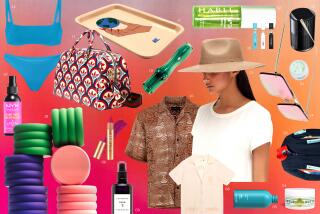Tanning With Sprays, Not Rays
- Share via
We’ve heard it a thousand times -- sun exposure causes skin cancer and wrinkles -- but who wants to look pasty year-round? And even as the weather gets cooler, Californians love to keep a sunny glow.
FOR THE RECORD:
Tanning products: An article about tanning sprays in Sunday’s Image section misspelled tanning technician Lisa Karadjian’s last name as Karadijian. —
Tanning beds are not an option. In July, the World Health Organization added UV-emitting tanning devices to its list of the most dangerous cancer-causing forms of radiation, underscoring an association between the devices and deadly melanoma of the skin and eyes.
What’s a health-conscious tan-seeker to do?
Try getting a guilt-free, sun-kissed glow through today’s array of sophisticated sunless tanning formulations. Long gone are the days of orange complexions and messy, streaky tans.
Half a dozen application options are available: DIY bronzing creams and sprays, at-home airbrush guns, spa applications, spray booths and, increasingly, mobile tanning technicians. Mobile tanners combine the convenience of using at-home products with the expertise of a salon application at a price of roughly $55 to $75 a session. However, in today’s economy every penny counts, so some clients throw spray-tan parties to get their glow at a discount. Mobile technicians offer attendees a group rate (usually $40 to $60 per person) while the hostess often receives a complimentary tan.
“The most obvious advantage is the discount, but it’s not always the driving force,” says Miranda Lynne, owner of MetropoliTAN Studio in downtown Los Angeles. Spray-tan parties offer an excuse to socialize or serve as a prelude to evening events. Attendees often indulge in cocktails and hors d’oeuvres while lounging in robes awaiting their turns.
“It’s a quick and easy way to unwind and have fun with your friends,” says Agoura Hills-based aesthetician Ashley Miller, who has attended several tanning parties put on by Girl Star Glow licensed aesthetician and tanning technician Lisa Karadijian. “I never go out in the sun for very long and I always wear sunscreen,” Miller says. “I still like to have a nice tan, but I refuse to get it naturally.”
For those with deeper pockets, celebrity tanner Jimmy Coco, who sprays the likes of Victoria Beckham and Eva Longoria Parker, offers a ritzy $2,400 tanning bash dubbed “Bronzing With Bubbly” for up to 10 people. But if you can’t afford the price, you can attend one of his “Rock the Tan” events, where, for $99, attendees can get a Hollywood glow while serving a larger cause since 5% of the proceeds go to the Skin Cancer Foundation. The event even has its own theme song sung by Coco, available on iTunes with sales benefiting the cause. (For more information, visit www.rockthetan.com.)
During the summer, Renata Shustin of Mocha Mist averages two parties a week. She sets up a pop-up tent to protect the host’s walls and furnishings. After reviewing each client’s needs, she offers a disposable bra, underwear, nose filters and a hair net. (Many women prefer a naked application to avoid tan lines.)
Each party attendee is taken into the tent individually for a custom application, which can take up to 20 minutes. As the client moves through a series of poses, a technician sprays the formula across the body to ensure even coverage, starting at the feet and working upward. Several tanning solutions are available, including those by Infinity Sun, Extended Vacation and Liquid Sun, many incorporating botanicals and antioxidants, along with the active tanning ingredient DHA, to moisturize and protect skin. Others contain bronzing agents for an instant shimmer that washes off after you shower.
These formulas work because DHA (dihydroxyacetone) reacts with dead skin cells in the outer layer of the dermis in a process called “reducing sugars” which causes skin color to darken. The FDA-approved ingredient is safe on all skin types, says Dr. Leslie Baumann director of the Cosmetic Medicine and Research Institute at the University of Miami.
However, she adds, DHA products should not be applied in the sun because they make skin more susceptible to sun damage during the chemical reaction, which can take up to 24 hours. It’s best to apply products the evening before you want to show off your glow.
Tanning professionals customize formulations for an even-looking tan and can contour the appearance of muscles or strategically shade areas for a slender illusion. Some post-tanning sprays, such as Infinity Sun’s Anti-Aging Elixir, which contains galacto arabinan, vitamins A and E, can help reduce the appearance of fine lines and tighten skin.
Before tanning (ideally, 24 hours in advance), experts advise clients to shower, shave, exfoliate and refrain from applying any creams or oil-based products that will prevent the tanning agent from working effectively. Also, wear loose-fitting dark clothing in case some of the color rubs off. Clients shouldn’t shower for up to eight hours after the application and should avoid exercise or sweating for up to four hours to prevent potential streaks.
Tans usually will last for about 10 days, but they can last a little more than two weeks with proper aftercare. Tan extenders containing DHA, such as Revive Plus Daily ($29; www.shopbiddiscombe.com), deposit small amounts of tanner to maintain and enhance the richness of the color, while moisturizers (Bath and Body Works Hold it Right There, $15; www.bathandbodyworks.com) can also make the tan last longer. Coco also suggests beta carotene and vitamin E supplements for a longer-lasting glow.


